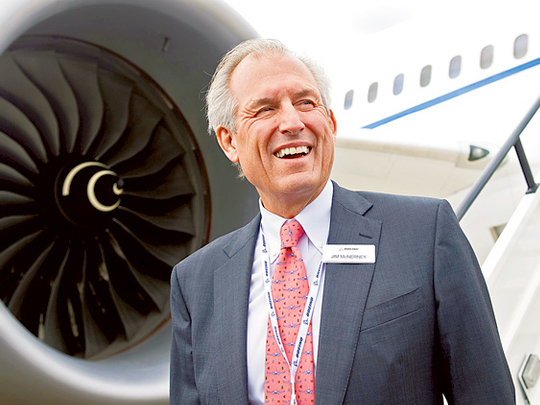
Seattle: Boeing Co chief executive Jim McNerney said the company wanted to be more like Apple Inc in the way it innovates, rather than doing a “moon shot” development every 25 years.
Speaking in Seattle at an annual conference with analysts, McNerney also said Boeing’s job was to improve execution and productivity to cut costs and boost margins. Building up technology and doing “a big a moon shot” every 25 years is the “the wrong way to pursue this business,” McNerney said. “We want to be more like Apple” by bringing out products more quickly.
Chief operating officer Dennis Muilenburg expanded the Apple comparison, saying Boeing’s 777X jet was an example of using evolutionary technology to create a revolutionary product. “We’re still going to deliver revolutionary capability,” he told analysts. “The way we deliver is to build on technology we have. We get to the same end point if you take 10 low-risk, well-managed steps rather than one big step.”
Apple has delivered a string of popular consumer electronic devices in the last decade, ranging from the MacBook notebook to the iPod Touch media player, the iPhone and the iPad tablet. Boeing chose to adapt technology to its 777X and 737 MAX aircraft rather than developing all-new jetliners such as the 787, with more than $20 billion (Dh73 billion) in deferred production costs.
Boeing’s defence, space and security unit plans to cut $2 billion in the next five years and capture a “disproportionate share” of growing international markets, McNerney added.
The Apple remarks underscored Boeing’s intense focus on wringing all the profit from its planes, rockets and other products by cutting costs in its factories and those of its suppliers. Cost-cutting and smooth-running assembly lines will ensure it has the cash to develop products and make good on promises to shareholders with dividends and share buy-backs.
Boeing made no change to its 2014 financial forecast, saying it still expects adjusted “core” profit of $7.15 to $7.35 a share on sales of $87.5 billion to $90.5 billion.
But the two-day analysts’ visit to Boeing’s jetliner centre also highlighted several challenges the company faces. Chief financial officer Greg Smith said Boeing is buying and storing parts for its 787-9 jetliner to ensure production runs smoothly after the first delivery in the summer. That may mean the overall cost of the 787 will not fall as quickly as forecast, but there will be a long-term payoff, he added.
Analysts said that forecast might worry investors, but the move would benefit Boeing by reducing the risk of schedule disruptions or cost overruns.
The deferred costs of the 787 stand at about $23 billion and are expected to peak at $25 billion in 2017 before subsiding as the cost of production falls below the sales price for the jet.
“We think additional de-risking here should ultimately help down the line,” RBC analyst Rob Stallard said in a note.
Muilenburg said Boeing’s products still cost far too much to develop when compared with the automotive and computer chip industries, and Boeing needed to break that pattern. “We think there’s huge opportunity here,” he added.









